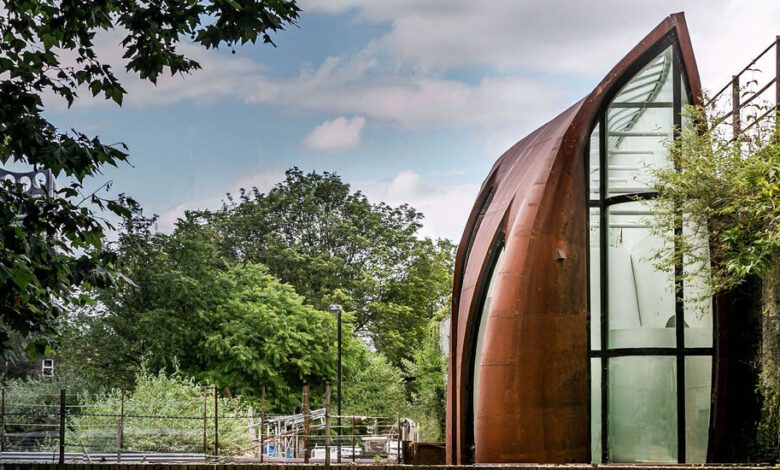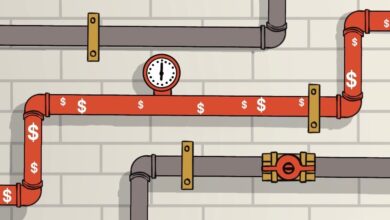House Hunting in England: Nestled in a London Viaduct for $1.3 Million

[ad_1]
A Two-Bedroom Marvel Built Into a London Viaduct
$1.3 MILLION (975,000 BRITISH POUNDS)
This arched two-bedroom, two-bath house is built below and beside an active 19th-century railway viaduct in South London. The open-plan home, covering 1,600 square feet, is wrapped in a rust-colored steel shell and brings in light through a slender three-story atrium.
The front door, clad in palm wood and topped with a square window, sits in an underpass below the viaduct. A two-door entrance hall acts as a physical and acoustic buffer between inside and outside, said Didier Ryan, the architect, who designed the home for his brother, completing it in 2012.
“When you come through the second door, it opens up into the vast, cavernous space of the arch,” Mr. Ryan said. “It’s such a big scale change that it’s an amazing surprise for people to come through that space.”
He added, “London a good percentage of the time has very gray skies, but in that space it’s perpetually very softly well lit.”
To prevent noise and vibrations from the passing trains above, the house was set on an elevated rubber foundation and constructed with layered materials — including its industrial steel shell — and cavities that act as sound buffers, much like double-pane windows.
Both ends of the ground floor — which is large enough for several groupings of furniture, including two long kitchen tables — are framed by a wide arch. On one side, near the entrance, a staircase leads to a small mezzanine with a built-in bookcase and enough room for a children’s playroom or office. Beneath it, behind a door, is the laundry room.
On the opposite side, where the ceiling opens up into the soaring atrium, is the kitchen, with an island and cabinetry that curves with the wall. Countertops, like the built-in bookshelf and the mezzanine stairs across the way, are reclaimed iroko wood. A tall wood-framed kitchen window looks out to some planted greenery.
A bedroom is to one side of the kitchen, and a bathroom with a cavelike, mosaic-tiled shower is on the other. A spiral staircase leads up to another mezzanine with the second bedroom on one end and a bathroom on the other. In between, a white staircase ascends to the top level, which has been used as a study and offers skylight views.
The home is situated in London’s Walworth neighborhood, steps from the 140-acre Burgess Park and from the South Bank area, home to several arts venues and a riverside walkway. Two London Underground stations are within a mile of the house. Heathrow Airport is about an hour by car, or 75 minutes by public transit.
Market Overview
Britain’s housing market had a surprisingly robust 2020 despite the country’s struggles with the pandemic. Even with a slight slowdown in January owing largely to a winter surge of coronavirus infections, the momentum has continued in 2021 thanks to low interest rates, the extension of government housing and job support, and the rollout of the Covid-19 vaccine, not to mention continued demand for larger homes and more outdoor space.
“I think the light at the end of the tunnel is certainly a great driver at the moment, and that’s another reason I think that the market is going to be very busy past Easter,” said James Klonaris, head of appraisals at The Modern House brokerage, which has this listing. “I think it’s all a question of staving off joblessness. If we can do that, I think the market will continue. And the pandemic has taught us that our living environments are hugely important.”
The Modern House ended 2020 with “probably the busiest market since 2015,” Mr. Klonaris said. A sales adviser at the brokerage, Jack Blythman, noted that the company has seen a 150 percent increase in website users since the start of 2021, compared with the same period in 2020.
After an eight-week pause during Britain’s first lockdown last spring, the market picked up quickly and barreled into Christmas.
“I don’t think any of us expected to come out the other side with such a strong market,” said Jonathan Hewlett, head of London residential at Savills. The global property firm reported a 10 percent growth in its British residential revenues from midyear 2020.
According to a December 2020 report by the Office of National Statistics (ONS), Britain saw its largest rate of annual house price growth since October 2014, with average house prices rising by 8.5 percent during the year and settling at a record high of 252,000 pounds ($347,000). The office’s January 2021 report showed the average at 249,000 pounds ($343,000), with prices also up in Wales (+9.6 percent), Scotland (+6.9 percent) and Northern Ireland (+5.3 percent).
London remained the most expensive area in Britain, with an average home price of 501,000 pounds ($691,000).
The December ONS report noted a “range of factors” for the increases, including reduced inventory, pent-up demand, shifting housing preferences amid the pandemic, and changes made to property transaction taxes. In July, the government placed the stamp duty land tax, a transaction tax paid on property purchases, on “holiday” through March 31, 2021. It has since been extended through June.
“We saw, obviously, the fairly well-established pattern now of people searching for more greenery and more space after the lockdown,” said Tom Bill, head of U.K. residential research at the property firm Knight Frank. “That certainly drove demand and drove activity to outer areas of London, the suburbs and also into the country.”
In prime central London, Savills also reported robust activity at the “absolute top end” of the market, Mr. Hewlett said.
Agents agreed that the greatest demand has been for large family houses with offices and outdoor space. However, travel restrictions prolonged by Britain’s spike in Covid-19 infections over the winter have forced foreign buyers out of the picture for the most part.
“Even with travel restrictions and very, very few international purchasers being in London, some international investors are certainly looking at buying off-plan units in new schemes,” Mr. Hewlett said, noting that the looming introduction of a 2 percent surcharge for overseas buyers on purchases of residential property is hastening activity.
Still, uncertainty over when foreign buyers will return to London is tamping down optimism for 2021, Mr. Bill said. “It might take a period of time to adjust,” he said, “so we’ve just reduced our forecast down for this year. We actually bumped it up a little bit for next year. We think demand is going to be probably displaced more into 2022.”
The hope is that the country is “on the verge of a sort of return to normality,” he said. “I think because the Covid cases are falling, because the vaccine program in the U.K. has been, relatively speaking, a success, because there is the prospect of summer holidays, I think what is happening now, we are starting to see supply come back in. And I think supply and demand are both, frankly, just getting stronger and stronger.”
Who Buys in London
Travel restrictions have altered the market’s demographics in Britain. “Usually we have quite a lot of American or European buyers, but that’s been less the case, unless they are domiciled,” Mr. Klonaris said.
In 2020, French buyers were the most prominent foreign presence in the central London market, “because they could get here more easily,” Mr. Bill said, noting that “Italians were fairly active as well.”
Before the pandemic, Chinese buyers dominated in prime Central London, followed by buyers from the U.S., Russia, India, Hong Kong and the Middle East.
Buying Basics
There are no restrictions on foreign buyers in England. Buyers and sellers use their own lawyers, and the seller pays the agent’s commissions, which is 2 to 3 percent.
If the property is a second home, a 3 percent surcharge is added. This is in addition to the 2 percent stamp duty surcharge for overseas buyers, which is slated to be introduced April 1.
“We believe there are still plenty of international purchasers out there wanting to live/invest in London, and many genuinely believe that they are buying as close to the bottom of the market as you can,” Mr. Hewlett said. “Especially as buyers are getting a discount of circa 20 percent from the peak in 2014.”
This property is for sale on a leasehold. Purchasers buy a lease from the landowner (usually referred to as the freeholder). The lease length for this property is approximately 850 years.
The Modern House warns that it is “unaware of any lenders currently providing mortgages on this house,” owing to the property’s nonstandard construction.
Websites
Languages and Currency
English; pound sterling (1 pound = $1.38)
Taxes and Fees
The ongoing stamp duty “holiday” means that “anything below 500,000 pounds ($689,000) is a zero rate,” Mr. Bill said. That is set to last through June 30, at which point the threshold will decrease to 250,000 pounds ($345,000) until Sept. 30.
The annual council tax for this home will be 1,867 pounds ($2,600) for the next financial year, said Mr. Blythman of The Modern House.
Contact
The Modern House, 011-44-020-3795-5920; themodernhouse.com
For weekly email updates on residential real estate news, sign up here. Follow us on Twitter: @nytrealestate.
[ad_2]
Source link






